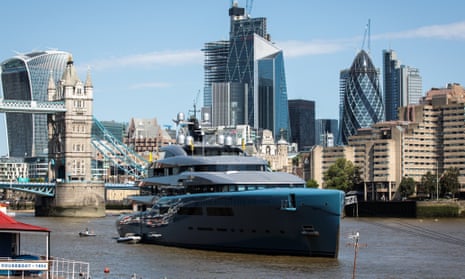From champagne corks flying towards a Picasso to cornflakes splashed on a Basquiat painting, the perils facing billionaires’ floating art collections aren’t those sailors typically fear on the high seas. But the world’s ultra-rich are filling superyachts with so many masterpieces that conservators are teaching captains and crew how to care for art as well as to pamper passengers.
Pandora Mather-Lees, an Oxford-educated art historian and conservator, started giving lessons after a billionaire asked for help to restore a Jean-Michel Basquiat painting damaged not by sea spray, but by breakfast cereal. “His kids had thrown their cornflakes at it over breakfast on his yacht because they thought it was scary,” Mather-Lees said. “And the crew had made the damage worse by wiping them off the painting.”
She declined to name the owner or identify the artwork, but a Basquiat painting depicting a crazed, skull-shaped face sold at auction for a US record $110.5m (£84.5m) in 2017.
The crew “just thought it was some painting, they had no idea it was worth many millions,” Mather-Lees told the Observer at a superyacht conference in London last week. “They are expected to know how to serve the owners at sea, not to know about paintings and art. But, now that the rich are increasingly bringing their art collections on board their yachts it’s vital that captains and crew know how to care for these pieces.”

There are superyachts with “better collections than some national museums,” Mather-Lees said, describing one yacht with more than 800 pieces of art that are worth more than double the vessel itself. “Obviously they [the owners] want to show off their art collection when guests come on board … It acts as an icebreaker, and says volumes about their taste,” she told an audience of more than 100 people at the Superyacht Investor conference in the Landmark Hotel. “But yachts are not art galleries and when something goes wrong it’s obviously very unfortunate and a big burden on the crew and the owners become very unhappy.”
Discretion is required in both the art world and on superyachts, but Mather-Lees said Sheikh Mansour bin Zayed al-Nahyan, the owner of Manchester City and deputy prime minister of the United Arab Emirates, has several hundred pieces aboard his £350m superyacht Topaz.
A reporter looking in the windows of Joe Lewis’s £200m superyacht Aviva, when it moored on the Thames last year, discovered Francis Bacon’s Triptych 1974–1977 was hanging in gold frames on the lower deck. The painting, whose subject is the death of Bacon’s lover George Dyer, was included in Tate Britain’s blockbuster Bacon and Freud exhibition last summer.
The British-born Lewis, who has an estimated £3.9bn fortune, owns a majority stake in Tottenham football club and lives in the tax-friendly Bahamas, has what he describes as “one of the largest private art collections in the world”. It includes paintings by Degas, Freud, Klimt, Modigliani, Matisse and Picasso, and sculptures by Moore, Degas and Di Modica. It is not known which are kept on his yacht.

Mather-Lees said that she saw a gap in the market for art awareness and handling lessons while walking around the Monaco yacht show, where the world’s biggest superyachts are displayed every September. “I was walking around and seeing talks about everything from flower arranging and wine connoisseur lessons, but no one was thinking about art and assisting the owners with care of their collections,” she said.
Her €295-a-day course aims to give crew an understanding of “the art collector and the intrinsic value of the objects on board” as well as knowledge of “where to go for specialist help in an emergency”.
Helen Robertson, a conservator at the National Maritime Museum in Greenwich, also advises the super-rich on caring for art at sea. “I used to work as a chief steward on superyachts so I have seen some of the problems first hand,” she said. “I’ve worked on a vessel with $450m of works of cultural value on board.
“Something people always say to me is ‘why on earth would you carry art on yachts?’,” she said. “But yachts can be very controllable. Systems for temperature and humidity can surpass those you would find in galleries.”
The most important thing was to make sure that all the crew were aware of the value of pieces.
She told of the crew who broke a £75,000 lamp. “It was the end of a Christmas and new year charter, and everyone was a bit worse for wear,” she said. “The crew decided to rugby pass the cushions from the deck into the saloon, and one of them hit the lamp.”
In another incident, a superyacht crew held an impromptu party in the owner’s quarters and a champagne cork struck the canvas of a multi-million pound work.
Tilman Kriesel, founder of an art advisory firm, told the conference one client asked how to display a Rothko that was too tall for a yacht’s grand saloon. “We turned the piece by 90 degrees,” he said. “The artist would probably be turning in his grave, but we took a deep breath and said ‘it’s your painting, do what you like’.”
Another of Kriesel’s clients had a piece by the Japanese modern artist Takashi Murakami that he wanted to display in the “beach club” – the rear of superyachts where owners access jet skis and other water toys – but again it was the wrong size. “In the end we cut it up to make it fit,” he said.
